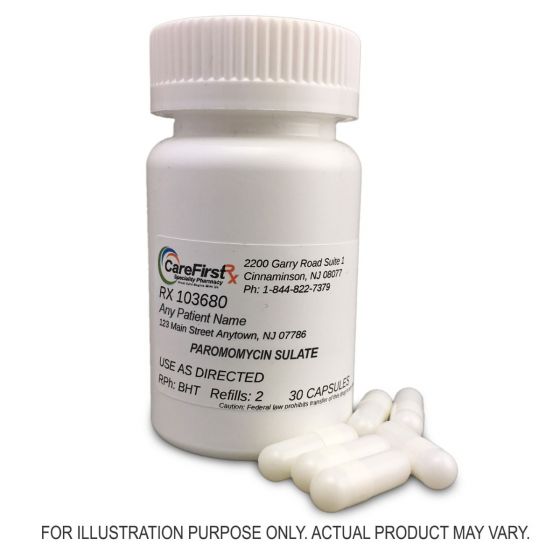Paromomycin topical for treatment-resistant Vaginal Trichomoniasis
Paromomycin topical for treatment-resistant Vaginal Trichomoniasis
By: Karan Modi
PharmD Candidate 2022
CareFirst Specialty Pharmacy
What is Trichomoniasis?
Trichomoniasis is a sexually transmitted infection (STD) with the urogenital protozoan Trichomonas vaginalis that typically manifests as vulvovaginitis in women or urethritis in men. It is one of the most common curable STD.
In the United States, CDC estimates that there were more than two million trichomoniasis infections in 2018. However, only about 30% develop any symptoms of trichomoniasis. Infection is more common in women than in men. Older women are more likely than younger women to have been infected with trichomoniasis.
Common Symptoms
In women: vulvar pruritus, burning, profuse vaginal discharge, rancid odor, and postcoital bleeding, although many are asymptomatic.
In men: itching or irritation inside the penis; Burning after urination or ejaculation; Discharge from the penis.
Risk Factors
- New or multiple sexual partners
- History of sexually transmitted diseases
- Exchanging sex for payment
- Injection drug use
- Douching
How do people get Trichomoniasis?
The parasite passes from an infected person to an uninfected person during sex. In women, the most commonly infected part of the body is the lower genital tract (vulva, vagina, cervix, or urethra). In men, the most commonly infected body part is the inside of the penis (urethra). During sex, the parasite usually spreads from a penis to a vagina, or from a vagina to a penis. It can also spread from a vagina to another vagina. It is not common for the parasite to infect other body parts, like the hands, mouth, or anus. It is unclear why some people with the infection get symptoms while others do not. Infected people without symptoms can still pass the infection on to others.
***Trichomoniasis can increase the risk of getting or spreading other sexually transmitted infections. For example, trichomoniasis can cause genital inflammation that makes it easier to get infected with HIV, or to pass the HIV virus on to a sex partner.
***Pregnant women with trichomoniasis are more likely to have their babies too early (preterm delivery). Also, babies born to infected mothers are more likely to have a low birth weight (less than 5.5 pounds).
Diagnosis
Clinical manifestations of trichomoniasis are non-specific and infection is often asymptomatic therefore accurate diagnosis of T. vaginalis infection requires appropriate laboratory testing.
Microscopic exam of wet mount preparation of vaginal secretions mixed with normal saline is most common diagnostic evaluation for T. vaginalis infection in women but is limited by poor sensitivity and negative wet mount specimens require confirmatory testing.
Nucleic acid amplification testing (NAAT) is recommended for the diagnosis of trichomoniasis.
Culture- of vaginal secretions in women or urethral swab, urine, or semen in men.
Treatment
According to CDC, Trichomoniasis is treated with metronidazole or tinidazole and these medications are taken by mouth. It is not recommended to drink alcohol within 24 hours after taking this medication.
Metronidazole and tinidazole are of the nitroimidazole class. They inhibit nucleic acid synthesis by forming nitroso radicals, which disrupt the DNA of microbial cells. This function only occurs when they are partially reduced, and because this reduction usually happens only in anaerobic bacteria and protozoans, it has relatively little effect upon human cells or aerobic bacteria.
***Vaginal trichomoniasis poses a difficult therapeutic challenge when metronidazole is ineffective or contraindicated. In such cases, Paromomycin topical can be a treatment option.
Paromomycin
Paromomycin, an aminocyclitol antibiotic derived from Streptomyces fradiae, has a spectrum of activity that includes many protozoa. This antibiotic inhibits protein synthesis by binding to 16S ribosomal RNA. It binds to the A site, which causes defective polypeptide chains to be produced. Continuous production of defective proteins eventually leads to bacterial death.
Case Study
One retrospective study done by Dr. Paul Nyirjesy and the team, from the Department of Obstetrics, Gynecology, and Reproductive Sciences, Temple University School of Medicine, has shown 6.25% Paramoycin cream was useful in the treatment of metronidazole resistant/allergy related trichomonas infection cases.
A case report, from the International Journal of STD & AIDS, documented by Sarup Tayal and the team, from the department of Genito-Urinary Medicine, The James Cook University Hospital, Middlesbrough TS43BW, UK, reports a 49-year-old woman with a five-year history of persistent Trichomonas vaginalis infection with a failed treatment of metronidazole and tinidazole was given a single course of intravaginal paromomycin which cleared the infection.

Paromomycin is commercially available in capsule form only. Topical paromomycin can only be compounded by a compounding pharmacy such as CareFirst Specialty Pharmacy
References
- Nyirjesy P, Sobel J, Weitz V, et al. Difficult-to-treat Trichominiasis: results with paramomycin cream. Clinical Infectious Diseases. 1998 April; 26(4):986-988. https://doi.org/10.1086/513951
- Tayal S, Ochogwu S, Bunce H. Paramomycin treatment of recalcitrant Trichomonas vaginalis. Int J STD AIDS. 2010 March; (21)3:217-8. Doi: 10.1258/ijsa.2009.009085
- https://www.dynamed.com/condition/trichomoniasis#OVERVIEW_BACKGROUND. Accessed May 26. 2021.
- https://www.cdc.gov/std/trichomonas/stdfact-trichomoniasis.htm. Accessed May 26. 2021.
- https://go.drugbank.com/drugs/DB01421. Accessed May 26. 2021.



Comments